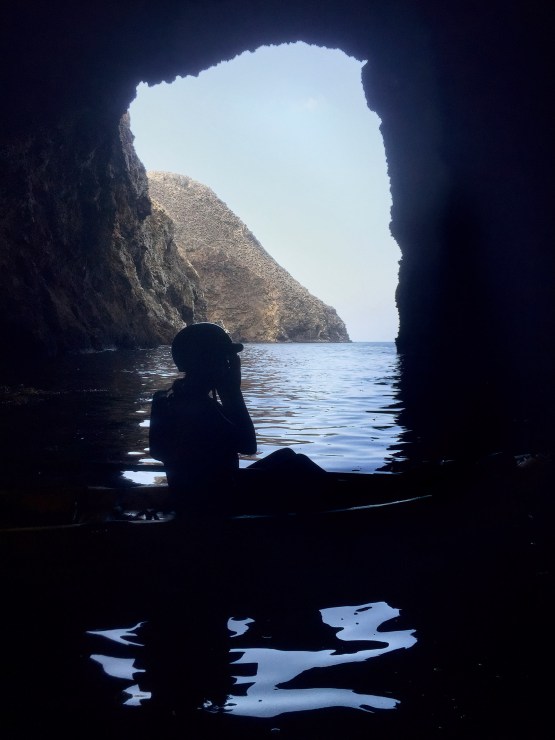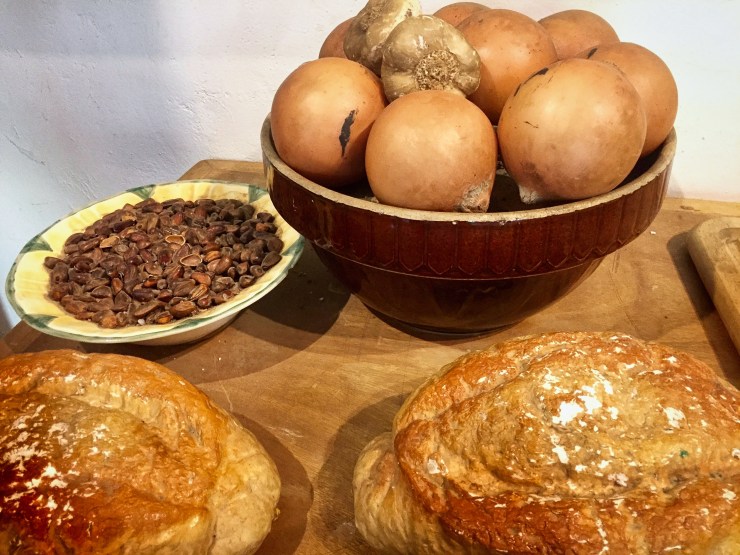It might surprise many people in Southern California that there is a beautiful national park so close. Channel Islands National Park consists of a chain of five islands.
The majority of visitors go to the two closest islands, Santa Cruz and Anacapa. Most people go to the islands from either Santa Barbara or Ventura. The islands offer a rare opportunity to photograph plants and animals, including scrub jays and a small fox not found anywhere else in the world. And as well, you may explore and photograph some of the best sea caves in North America.

We have gone to Santa Cruz island twice from the town of Ventura, riding on a boat for one hour via operator Island Packers while watching dolphins and seals swim alongside us.
Kayaking

The first time we went to Santa Cruz Island, we booked the Adventure Sea Cave Kayak Tour kayaking trip with Channel Islands Adventure Company. We could not resist three hours of exploring sea caves.
Keeping the camera dry while kayaking

Since I was kayaking, I decided to go for convenience and not bring either of the DSLRs that I ordinarily use for night photography.
I wrapped my iPhone 6 — the phone I had at the time — inside a waterproof phone pouch. This produced a slight gauze around the photos, but kept my phone dry … a fair trade-off. The tour was extremely well-organized and safe. Our guide Pablo told us about many aspects of the sea caves, history, wildlife and more.
Hiking

We had explored Santa Cruz Island by sea the first time. For our second visit, we would explore it by land.
We left from Scorpion Beach, where we had launched our kayak tour before. This time, we decided to hike to Smugglers Cove. This was an eight-mile hike with approximately 1,400 feet of elevation gain in total, and would take about 4–5 hours.
The trail went uphill and continued winding along the coast and up the mountain. In the interior, it became noticeably warmer for a while before heading downhill toward Smugglers Cove.

Along the way, you can see some cypress groves. Also of note were the many stone piles found throughout the island. These were constructed by Italian stone masons and laborers between 1880 and 1900 for the Justinian Caire family, which owned the island at the time. This was done to clear the land for planting wheat, corn, potatoes, beans, barley, onions, hay and alfalfa between Scorpion and Smugglers Cove.
Photographing the mountains and coves

The island, as you would imagine, is extremely photogenic. Much of the way, we had somewhat foggy but gorgeous views of the mainland and Anacapa Island across the blue waters of the Pacific.
I used a Pentax K-1 with a 28-105mm lens. This lens offered enough flexibility for relatively wide-angle photos as well as zooming in. And the Pentax’s exceptional water-resistant quality would be a bonus when taking photos near the ocean water.
I carried this in my backpack along with a gallon of drinks, water sports shoes, and food.
Camping
Channel Islands National Park also offers camping. The largest sites are Scorpion Anchorage on Santa Cruz Island and Water Canyon Camp on Santa Rosa Island.
The islands are wonderfully free of much else except for ranch property from previous owners. There are no hotels, gift shops, nail salons or pet grooming on the islands.
Unique animals and plants

One of the remarkable aspects of the Channel Islands is its isolation from the mainland. This has resulted in animals that are endemic to the islands. For instance, the island fox (Urocyon littoralis) is a fox about the size of a house cat that is endemic to six of the eight islands. Furthermore, there are six subspecies. Each of these are unique to their respective islands. They are the smallest fox in North America.
The fox’s isolation, however, means that they are particularly vulnerable to parasites and diseases brought in from the mainland. Four of the island fox subspecies are now federally protected as an endangered species.
The National Park Service is also in the process of encouraging native plants and shrubs that had been all but destroyed due to grazing from pigs and other livestock, which were brought to the island by ranchers.
Rare opportunities for photography
You have the opportunity to photograph plants and animals not seen anywhere else. The rare island fox are easily seen throughout the island and can be easily photographed. You might also see sea life and bald eagles, the latter of which are being reintroduced by the National Park Service. And of course, there are the amazing sea caves, cliffs, mountains and cypress groves.
If you look hard enough, you may also see signs that the Chumash lived here. They lived on Santa Cruz Island for approximately 9,000 years, and had a complex society of villages engaged in marine harvest, craft specialization and trade with mainland groups.

The drama behind Santa Cruz Island
The island had been the largest privately owned island in the United States, and had owned by one family since 1880 up until 1997. They ran a ranching operation, also leasing the property for hunting and recreation.
After that, the story of the family and the federal government acquiring the island involves tales of destruction of native animals and plants, grave robbing, accusations of government seizure involving “Rambo-like” raids by agents wearing ski masks, armed hunters making threats against park rangers and stolen Native American artifacts.
You may find it comforting that you will have none of this drama while photographing, kayaking, hiking, camping or exploring the island. It is gorgeous and well worth the short trip from the mainland.
Tell your story with the second annual Visual Storytelling Conference!
Experience four days of interactive, online training sessions featuring a range of educational content with experienced photographers and content creators. This free event kicks off with a series of technical boot camps to build essential skills, followed by live, online sessions on photography, video, business and social media. Join live from March 10-13, 2022!
